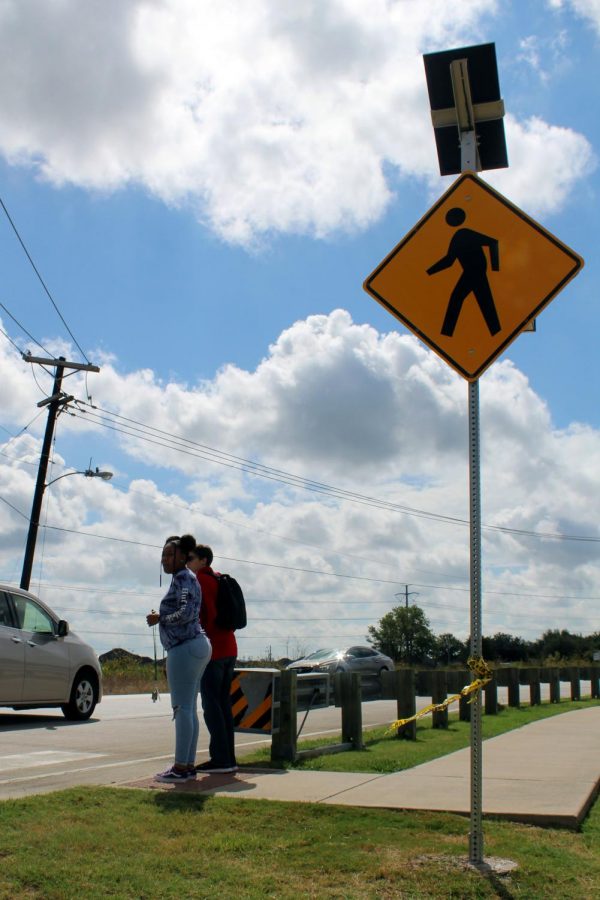The Dangers of Day Miar
Students wait for the proper time to walk across the Crosswalk
Last week, Lake Ridge experienced a horrific event when a freshman was hit attempting to cross Day Miar Road to get to his ride after school. The news swept across the community grabbing the attention of students, teachers, and parents with reactions of sorrow and shock. Many questioned how something like this could happen. However, many students found themselves less than shocked, almost expecting this event to occur. Students who cross Day Miar every day to get to and from school know what it’s like to almost get hit by cars and may worry that what happened last week could also happen to them.
Students who live in the neighborhoods near Lake Ridge, such as Mira Lagos, rely on walking, biking, or even skateboarding to get themselves to school each day. The roads within each neighborhood are relatively safe with comfortably wide sidewalks for students to walk on, however when students leave the safety of their neighborhoods and attempt to cross Day Miar is when the worries begin. Students, such as junior Araceli Juarez, recall incidents where they feared being hit by cars while crossing from this location.
“Since there’s no sidewalk over there you have to walk on the street right next to the line so there’s a huge chance of getting hit by a car. So when that accident happened I wasn’t too surprised. Of course I felt bad because that shouldn’t happen to anyone. But at the same time this just proves that we need a sidewalk over there,” stated Juarez.
Until recently, Juarez commuted to school by walking each day. Juarez attained her license and now drives herself and her sister to school instead of walking, but she still remembers what it was like to walk each day.
“Walking on the street is the part that is scary. It’s scary because, especially in the morning people can’t see you and a lot of cars don’t want to stop for you. Even though you as the pedestrians have the right of way some people just don’t care to stop,” stated Juarez.
Juarez stresses the danger of crossing Day Miar, even with the crosswalk. She remembers being scared in the morning to cross after almost getting hit twice on her way to school.
“I almost got hit and both were in the morning. One time I was walking through, because I have the right of way, and this person wasn’t paying attention so they slammed on their brakes. And then the second time was when a person didn’t want to stop and so they passed me but I was right next to their car,” sated Juarez.
Some students ride their bicycles to get to school. Junior Kelsey Gilbert has been biking home from school almost every day since her freshman year. Due to the dangers of the street, Gilbert prefers biking on the sidewalk.
“I feel a lot safer on the sidewalks since it’s not too close to the street and the cars. Also, drivers don’t often take into consideration to stop and let people cross the street,” stated Gilbert.
Luckily each of these students were able to continue crossing and make their way to class with little effect towards the rest of their day. However, for junior Alimat-Shadiyat Akintola, this was not the case. Akintola recalls a time when she almost got hit herself.
“Last year I almost got hit by a car to the point where the person had to come around and apologize for almost hitting me. And ever since then I have a trauma crossing the street by myself and I have to wait for other people to cross with me or I get anxious,” stated Akintola.
Because of her incident last school year, something Akintola’s AP U.S. History teacher, Ryan White, recently said really hit home with her. White, explained the way that people who experienced heavy traumas, such as 9/11, have a tendency to vividly remember their traumatic memories. Akintola resonated with what White said while thinking of almost getting hit herself.
“Mr. White was talking about how moments of trauma that have a big impact on you can still be remembered like they were yesterday. Even though it was last year that I almost got hit I can still remember it vividly. I can remember the way I jumped, what I was wearing, I can remember the color of the car, what the guy was doing in his car, what he looked like, his daughter sitting beside him. It was a black sports car and I was about to get his license plate but he drove off too quickly. I even held my palms out and the lights were really bright since it was so dark in the morning,” stated Akintola.
Akintola now questions what might have happened if the driver never stopped.
“I was scared. I just kept thinking, what if I got hit by that car? Who knows, because I like to dance, I could have been paralyzed or it could have just ruined my life. It could have been such a bad hit because he was going so fast, anyone could tell that he was speeding as if he wasn’t in a school zone.”
These traumatic events stay with students. The truth is that many students believe that what happened last week not a surprise, and the new question arises, what more has to happen before that road is made truly safer?

